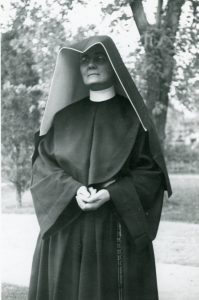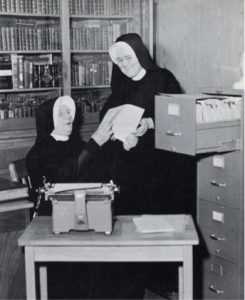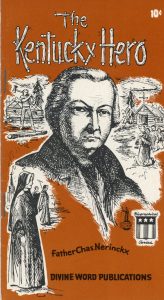Our Second Archivist, M. Matilda Barrett
Posted on March 8, 2018, by Loretto Community
By Katie Santa Ana

In June of 1968, author Paul Horgan wrote to Sister Mary Luke Tobin SL:
“I have never forgotten the kindness and generosity of my reception at Loretto; and Sister Matilda’s lovely enthusiasm, her warm eagerness to help a fellow-scholar, and her imaginative search for materials touched me greatly. Even since I was with her in your archives, she continued to send me new items as they came to light. I felt her blessing of my project as a really sustaining thing. I shall have much honor from acknowledging her help when my book is ready.”
He was referring to Sister M. Matilda Barrett SL – second archivist of the Sisters of Loretto – and was true to his word: when his book Lamy of Santa Fe was published in 1975, both Barrett and Tobin’s names appeared in the acknowledgements. Hagan went on to win a Pulitzer Prize for History for his work in 1976.
But who was this Sister of Loretto who went above and beyond in her duties as archivist? Born Mary Barrett on July 20, 1892 on a farm near Whitesville, Kentucky, she attended Bethlehem Academy in St. John, Kentucky. Mary entered Loretto Novitiate in 1912, received the religious name Matilda, and professed final vows August 15, 1918. In 1930, Matilda graduated from Loretto Heights College in Denver, Colorado. For the first couple decades of Matilda’s religious life, she served at many Loretto schools across the United States as both a teacher and administrator, including at Nerinx Hall in Webster Groves, Missouri as principal for one year in 1939. Matilda was then sent to St Mary’s High School in Colorado Springs in 1940, the same year she completed her Masters of Arts through Notre Dame University. By 1943, Matilda was on the move again as she went to Loretto Academy in Santa Fe to serve as principal. However, Matilda’s bustling career in the schools was interrupted in August of 1944 when Mother General Edwarda Ashe wrote requesting she return to Loretto Motherhouse to assist the aging Sister Antonella Hardy in the archives. Matilda acted as assistant until Antonella’s death in 1955, when she assumed the role of archivist.

In 1959, her scholarly work began to gain more widespread recognition following a visit to Loretto Motherhouse by John Tracy Ellis, Professor of Church History at The Catholic University of America. In subsequent correspondence about his research on Kentucky pioneer priest Father William Joseph Howlett, Matilda shared with Ellis her own 1940 thesis in which she edited Howlett’s memoirs with notes to the original source material. After seeing her work, Ellis realized she had already accomplished what he had set out to do with his own research, and encouraged her to publish. In 1960, Matilda won the first annual Cardinal Spellman Prize and $250.00 from the United States Catholic Historical Society for her work on Howlett’s memoirs. As part of the award, “The Memoirs of Father William Joseph Howlett” was published in Historical Records and Studies Volume XLVIII, two decades after she completed her thesis.

During her tenure as archivist, Matilda made many contributions to the recording of Loretto history, including pamphlets “The Kentucky Hero: Rev. Charles Nerinckx” published by Divine Word Publications in 1960 and “Courage American: A sketch of the life of the Lorettine foundress,” printed by Schuhmann Printing Co. in 1962. Her most ambitious work however, was to write the history of the Sisters of Loretto as part of the Sesquicentennial celebration of the congregation. Unfortunately, the project was interrupted by Matilda’s death in 1968 following a short illness, but the first portion of the history was edited and produced posthumously as “One Hundred and Fifty Years: Part I 1812-1890” and her unfinished narratives on the Loretto schools incorporated into the archives school files.
Looking back at Sister Matilda’s life, it’s hard to imagine how she found the time to accomplish all that she did. On top of her many regular duties, she also managed to keep a diary most years, record the annals of Loretto Motherhouse, assembled a notebook of her poetry (which she gifted to Mother Superior Edwarda Ashe on Christmas Eve, 1944), and wrote a list of over six hundred Loretto history trivia questions! We’ll leave you with a few of those questions to remember Matilda by:
Question: What Sister of Loretto was given a military funeral?
Answer: Sister M. Jean Connor SL, who died of influenza after nursing soldiers at Camp Zachary Taylor during the Influenza Pandemic of 1918
Question: Which Mother Superior rescued a Sister from drowning in a well in which the Sister had fallen?
Answer: Mother Superior Bertha Bowles at Bethlehem Academy in St John, Kentucky
Question: Who was the first high school graduate in Colorado?
Answer: Jessie Forshee, later Sister M. Vitalis Forshee SL, at St. Mary’s Academy
Question: What Sister on coming to the convent in 1885 brought as her dowry lumps of gold tied up in a handkerchief?
Answer: Sister Josefa Escobar SL, whose father managed a gold mine in Mexico
